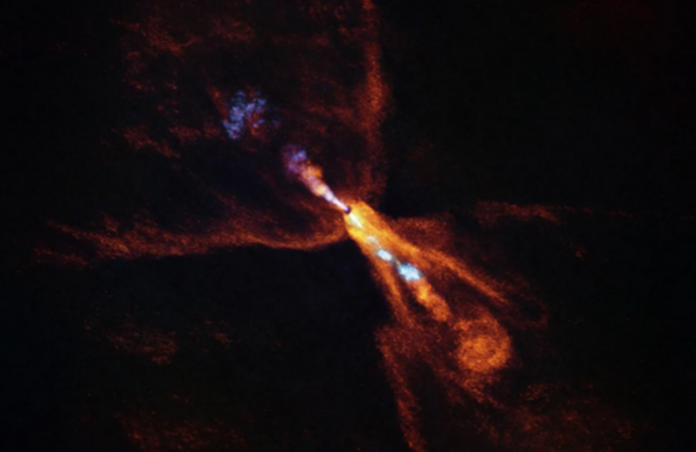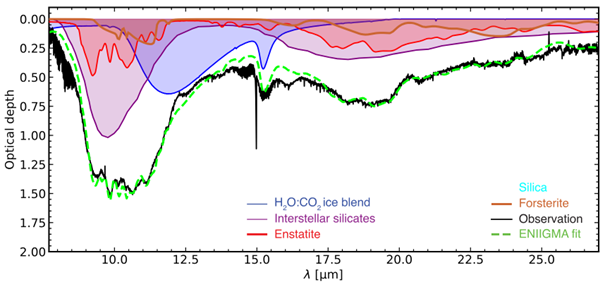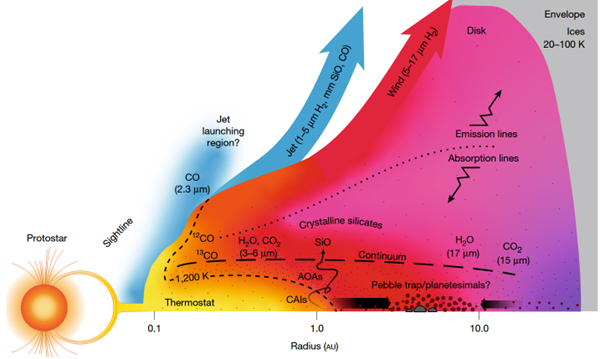First Direct Observation of Planetary Formation Mechanisms

Current planetary formation models propose that as the gas and dust around a young star cools, refractory materials begin to condense. These tiny particles collide and stick together through electrostatic attraction, forming larger clumps. As these grow, gravitational attraction becomes increasingly dominant, leading to the formation of rocky planetesimals, within timescales of ~106 years. These continue to grow, until they can eventually settle into orbit as full-sized planets.
A new study led by M. K. McClure shares the first ever detection of a planet during these brief moments during its initial formation. This exciting moment was captured around the young protostar HOPS-315, located about 1300 light-years away. These observations were jointly made using the James Webb Space Telescope (JWST) as well as the Atacama Large Millimetre Array (ALMA). Leveraging spectroscopic data captured by these systems, the team managed to identify multiple refractory solids within the disk itself.

First, high-resolution spectra of the system were captured using the JWST's NIRSpec and MIRI instruments. These were subsequently fitted using a genetic algorithm called ENIIGMA, an open-source tool specifically designed to decompose infra-red spectral data of ices. It does so by fitting laboratory ice spectra to any observed data with similar features. This revealed statistically significant amounts of forsterite (Mg₂SiO₄) and enstatite (MgSiO₃) within the disk. As prominent refractory minerals, their presence indicates they must have condensed from the high-temperature gas phase within the inner regions of the disk. Crucially, once these minerals are incorporated into larger bodies, they are no longer detectable within the infra-red spectrum of the disk, suggesting this process began quite recently, or is still ongoing.
These results were assisted by models of the gas dynamics, including temperature, column density and velocity. HOPS-315 also hosts a substantial, high-speed ejecta, necessitating careful consideration of whether these materials are indeed found within the disk. Based on the redshift of the relevant lines, the authors manage to attribute these to the slow moving disk.

However, most importantly, HOPS-315 and its protoplanetary disk exhibit a striking compositional resemblance to our own Solar System. Evidence from the internal composition of meteorites suggests that condensation in the early Solar System also started with similar silicon-rich solids. Their models of grain growth also suggest that these must have formed on comparable timescales.
This discovery presents a glimpse of what our Solar System might have looked like during its earliest stages and provides a unique window into the beginnings of planetary birth. However, other key refractory minerals remain tentatively detected, such as silica (SO2) only being found within a 3σ confidence boundary. The authors discuss how refining their models to incorporate temperature gradients and grain mixing could help alleviate these uncertainties. Furthermore, broader surveys would be essential to determine whether the conditions observed within the HOPS-315 system resemble our Solar System’s genesis by chance, or whether they represent a more common stage of planetary formation.
--
Journal Source: M. K. McClure et al., Refractory solid condensation detected in an embedded protoplanetary disk, Nature Astronomy, (2025), DOI: 10.1038/s41586-025-09163-z
Cover Image Credit: ALMA(ESO/NAOJ/NRAO)/M. McClure et al.
